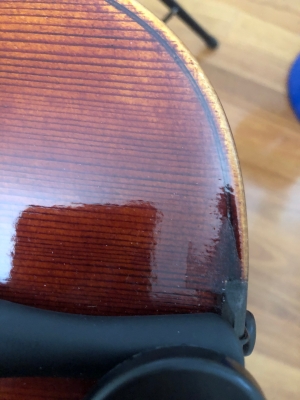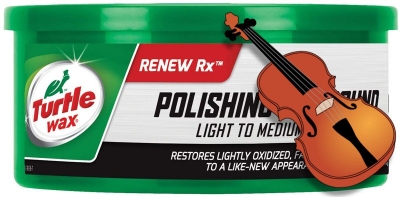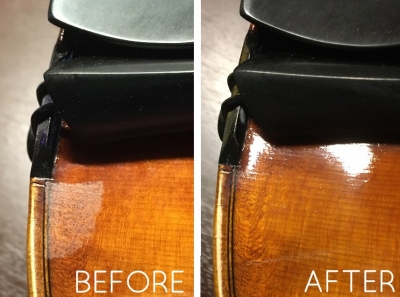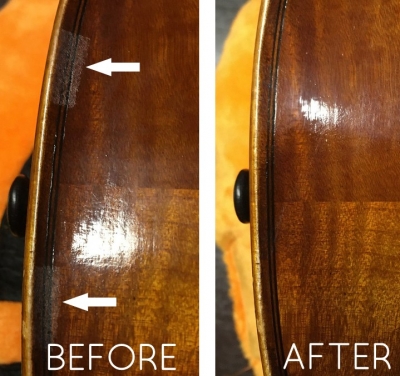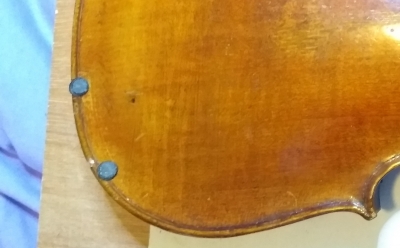Welcome to our forum. A Message To Our New and Prospective Members . Check out our Forum Rules. Lets keep this forum an enjoyable place to visit.
Currently working on errors from the latest (SimplePress) forum update. Many issues have been resoled and others are being worked on. Thank you for your patience.
 Topic RSS
Topic RSS



 (0 votes)
(0 votes) Member
 Offline
OfflineFiddlerman said
This is quite common when a chinrest sits on an instrument for an extended period of time. Good varnish is on the softer side in order to not muffle the instrument too much. Softer varnish can't withstand the pressure of a chinrest. What we do here is to use a blend of alcohol/oil/vinegar/water and soap but I don't recommend that you experiment. If you were local I would ask you to drop by and our luthiers would take care of it for you.I'll ask my luthiers what they would suggest. Perhaps some wax but I'm not sure.
I’m not local. I live in Australia.
Regulars
 Offline
Offline

@bunify and others. Your instrument is in rarified air in comparison to my lot. If you plan to continue with the current chin rest, the best option is likely to do nothing.
If you are going to replace the current chin rest AND the finish blotch bothers you, I would first try placing a small amount of naphtha (lighter fluid) on a cotton swab or soft cotton rag and rub the solvent gently on the offending area. A more aggressive option would be the use of semi chrome metal polish or a dab of tooth paste (non gel type) on a soft cotton rag.
Success is the progressive realisation of a worthy ideal. —Earl Nightingale.
Honorary tenured advisor
Regulars
I would not recommend you use anything that has alcohol or naphtha yourself unless you really know what you are doing. You could damage the varnish.
Cork residue is quite common. A friend of mine had the same problem when she changed her chinrest out for another. She researched it and used Turtle Wax car wax. It took a few applications, but you can easily see she got a perfect finish. (These are her actual before/after pictures from her blog.) BTW...she told me she found the recommendation here on the Fiddlerman Forum from a few years back.
Jim
Regulars
 Offline
Offline

@MoonShadows and others. Thank you for your comment above, which allowed me to do some further investigation.
A paste wax needs to be dissolved in a carrier which allows it to be spread on a surface. The wax adheres to the surface as the carrier solvent evaporates. The paste wax that I own is Lundmark (carnauba wax carried by naphtha).
Turtle Wax products are more than a little coy concerning the ingredients, but I did find the appropriate MSDS sheet. The petroleum carrier is listed as a hydro treated petroleum distillate, which means that a hydrogen atom is added in the presence of a catalyst. Naphtha is created in this manner, and though the Turtle Wax carrier might contain more or fewer molecular chains in its formula (likely varied from market conditions), performance should be similar.
Turtle Wax contains kaolin clay, which is a useful abrasive. A DIY substitute would be plumber’s putty. I do not think the problem raised by the original poster would require it.
The ingredient that would concern me with Turtle Wax is that synthetic silicone based waxes are used. Attempting to apply varnish on a surface treated with this material would be exceedingly difficult.
The Turtle Wax will likely work, but be clear that naphtha (or similarly created petroleum distillate) remains as part of the bargain. My preference would be to limit instrument exposure to a minimum of reagents.
Success is the progressive realisation of a worthy ideal. —Earl Nightingale.
Honorary tenured advisor
Regulars
Fiddlerman actually recommended to someone to try Turtle Wax from a post back in 2014: https://fiddlerman.com/forum/f.....ix/#p64970 ,but there are others solutions as well.
Personally, I would go with the Turtle Wax if I had to do this procedure after seeing the great job it did on my friends fiddle without any harm. Others may prefer other methods, which is fine and a personal decision.
Jim
Honorary tenured advisor
Regulars
Regulars


cid said
Personally, I have that mark on my Doetsch violin. It was there when I bought it new...
My old German fiddle has not only the marks, but the rubber pads themselves have detached from the chin-rest and adhered firmly to the back. It's benign I guess, and locates the chin-rest when I re-fit it. I wonder if they've ever been off the varnished surface since the violin was originally fitted-out by the maker:
Peter
"It is vain to do with more that which can be done with less" - William of Ockham
"A crown is merely a hat that lets the rain in" - Frederick the Great
Honorary tenured advisor
Regulars
I think there is a difference when you have/buy violins not only for their sound but their appearance (a.k.a. "character"). My teacher's fiddle looks like it has been through a war, but I love the character and wouldn't change it one bit if I owned it. But, some folks buy new violins and want to keep them looking their best, and while things like cork residue or a scratch/nick here or there will not affect to quality of sound, it does affect the beauty if you are trying to keep the instrument looking pristine. It's the proverbial first scratch on a new car.
For me, if I had cork residue, I would remove it. For me, that is not character...but, the little nicks/scratches/blemishes, etc. I already have collected on my two Fiddlerman violins ARE character and I have done nothing to "fix" them. For me, that is character.
Jim


 Log In
Log In Register
Register




